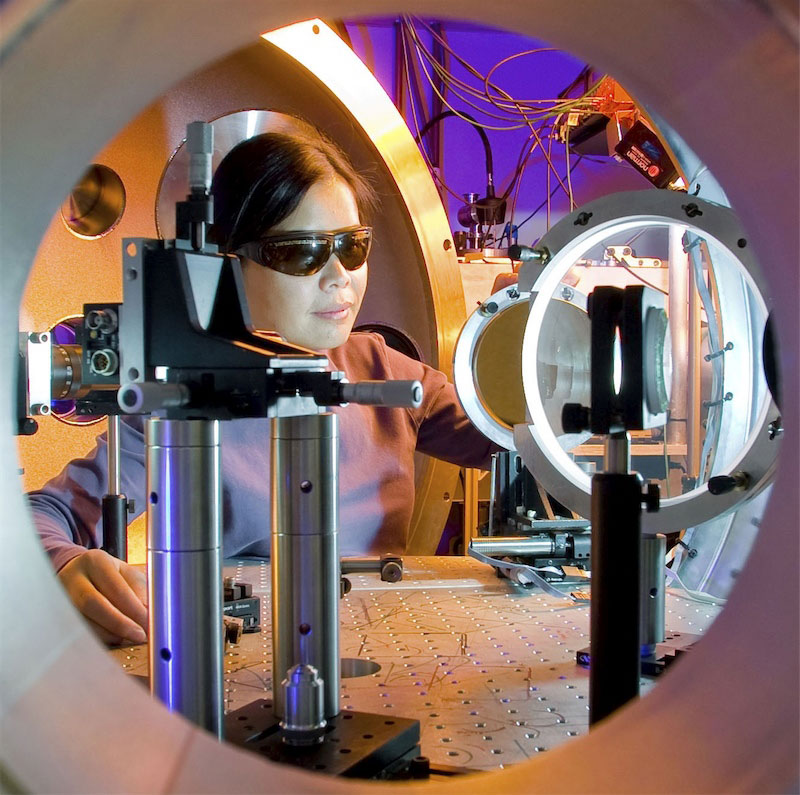Lasers Provide Antimatter Bonanza
A research team used lasers to produce more positrons (anti-electrons) inside a solid than any previous experiment, according to the researchers involved. In the 13 March Physical Review Letters, the team describes firing short pulses from an intense laser onto thin gold targets and creating a high-density positron source that could be used to investigate exotic phenomena near black holes or supernovae.
Researchers currently produce positrons using one of two methods. At low energies, from a few to a few thousand electron-volts, they are obtained from radioactive isotopes, as in positron emission tomography (PET), a medical imaging technique. Alternatively, particle accelerators can produce positrons with energies of billions of electron-volts.
Hui Chen and Scott Wilks of the Lawrence Livermore National Laboratory in California and their colleagues now report that they have generated copious amounts of positrons with intermediate energies–in the range of a million electron-volts. They fired picosecond pulses with intensities of around watts per square centimeter from the Titan laser at Livermore’s Jupiter laser facility onto millimeter-thick gold targets. Positrons were produced via the “Bethe-Heitler” process, in which part of each laser pulse creates a plasma on the surface of the target, and the remaining part of the pulse then blasts electrons from the plasma into the solid. Next, the electrons are slowed down by gold nuclei, an interaction that generates gamma-ray photons. The gamma rays then interact with more gold nuclei and transform into electron-positron pairs.
The team detected the positrons using a pair of spectrometers, one positioned behind the target and the other to the side of the target, at 95 degrees to the beam, on the laser side. These custom-built detectors provided more complete and high-resolution data than was available for any similar experiments in the past, and they allowed the team to document their high positron output and attribute it to the Bethe-Heitler process.
Using the spectrometer data along with a theoretical model of the positron creation process, they worked out the density of positrons created within the solid target. Their figure of positrons per cubic centimeter is the highest ever obtained in a laboratory. 90 percent of these positrons don’t have enough energy to escape the solid, but the positron output still far exceeded the two previous similar experiments, performed by others almost a decade ago. Chen, Wilks, and their colleagues had better target design and other equipment improvements.
10 times more positrons appeared at the rear detector than at the front, demonstrating a large anisotropy, which is quite different from the uniform haze of positrons emitted by a radioactive source. This, says Chen, could make laser-generated positrons useful in studying processes that are themselves anisotropic, such as the jets of electrons and positrons that may be produced by black holes and other highly energetic astrophysical sources.
The team also proposes using their positron source to learn about gamma ray bursts, the extremely luminous flashes that occur throughout the universe. The gamma radiation could come from the annihilation of electron-positron jets, and “You could imagine sending two jets into each other, or a single jet into another material, and measuring the radiation,” says Chen. The high concentration of positrons and electrons inside the solid form a plasma that she says may also mimic aspects of gamma ray bursts.
The world’s largest laser, Livermore’s National Ignition Facility, opened this year, and Chen says the energy per shot in short-pulse mode could be 40 times more than Titan. “We should therefore be able to create more antimatter here than anywhere else.”
Donald Umstadter of the University of Nebraska in Lincoln says the work is a “step along the road towards a laser-based positron source that is useful for applications.” He says the specialized positron spectrometers allowed the team to demonstrate the importance of the Bethe-Heitler process and shows “how a simple improvement in instrumentation can often lead to better understanding of complex physics.”
–Edwin Cartlidge
Edwin Cartlidge is a freelance science writer in Rome.





